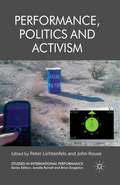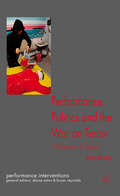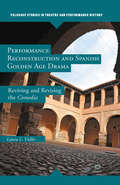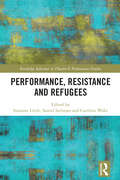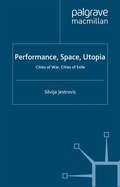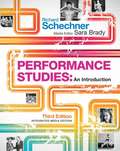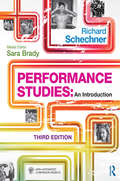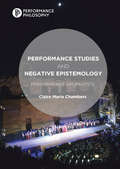- Table View
- List View
The Performance of Sculpture in Renaissance Venice (Routledge Research in Art History)
by Lorenzo G. BuonannoThis study reveals the broad material, devotional, and cultural implications of sculpture in Renaissance Venice. Examining a wide range of sources—the era’s art-theoretical and devotional literature, guidebooks and travel diaries, and artworks in various media—Lorenzo Buonanno recovers the sculptural values permeating a city most famous for its painting. The book traces the interconnected phenomena of audience response, display and thematization of sculptural bravura, and artistic self-fashioning. It will be of interest to scholars working in art history, Renaissance history, early modern art and architecture, material culture, and Italian studies.
The Performance of Viking Identity in Museums: Useful Heritage in the British Isles, Iceland, and Norway (Routledge Research in Museum Studies)
by Guðrún D. WhiteheadThe Performance of Viking Identity in Museums explores the representations and uses of Vikings in museums across Iceland, British Isles and Norway.Drawing on theories from history, philosophy, museology, and sociology, the book analyses how the Viking myth is used by visitors to make sense of present-day society, culture, and politics and the role of museums in this meaning-making process. Demonstrating that the Viking myth is present in collective memory and plays an important role in the construction and modification of collective, national, and personal identities, the book analyses this process through the framework of museums and their visitors. Identifying museums as places where heritage, identity and social norms are affirmed and reflected upon, Whitehead demonstrates that all countries use their Viking heritage to define their identity on a local and international level - through tourist attractions such as museums and other Viking-related monuments and merchandise.Providing readers with an insight into Vikings and their social relevance today, The Performance of Viking Identity in Museums will be of great interest to academics and researchers across the social and human sciences. It should also be essential reading for museum professionals working in museums around the world.
The Performance of Viking Identity in Museums: Useful Heritage in the British Isles, Iceland, and Norway (Routledge Research in Museum Studies)
by Guðrún D. WhiteheadThe Performance of Viking Identity in Museums explores the representations and uses of Vikings in museums across Iceland, British Isles and Norway.Drawing on theories from history, philosophy, museology, and sociology, the book analyses how the Viking myth is used by visitors to make sense of present-day society, culture, and politics and the role of museums in this meaning-making process. Demonstrating that the Viking myth is present in collective memory and plays an important role in the construction and modification of collective, national, and personal identities, the book analyses this process through the framework of museums and their visitors. Identifying museums as places where heritage, identity and social norms are affirmed and reflected upon, Whitehead demonstrates that all countries use their Viking heritage to define their identity on a local and international level - through tourist attractions such as museums and other Viking-related monuments and merchandise.Providing readers with an insight into Vikings and their social relevance today, The Performance of Viking Identity in Museums will be of great interest to academics and researchers across the social and human sciences. It should also be essential reading for museum professionals working in museums around the world.
Performance-Oriented Architecture: Rethinking Architectural Design and the Built Environment (Architectural Design Primer)
by Michael HenselArchitecture is on the brink. It is a discipline in crisis. Over the last two decades, architectural debate has diversified to the point of fragmentation and exhaustion. What is called for is an overarching argument or set of criteria on which to approach the design and construction of the built environment. Here, the internationally renowned architect and educator Michael Hensel advocates an entirely different way of thinking about architecture. By favouring a new focus on performance, he rejects longstanding conventions in design and the built environment. This not only bridges the gap between academia and practice, but, even more significantly, the treatment of form and function in design. It also has a far-reaching impact on knowledge production and development, placing an important emphasis on design research in architecture and the value of an interdisciplinary approach. Though ‘performance’ first evolved as a concept in the humanities in the 1940s and 1950s, it has never previously been systematically applied in architecture in an inclusive manner. Here Michael Hensel offers Performance-Orientated Architecture as an integrative approach to architectural design, the built environment and questions of sustainability. He highlights how core concepts and specific traits, such as climate, material performance and settlement patterns, can put architecture in the service of the natural environment. A wide range of examples are cited to support his argument, from traditional sustainable buildings, such as the Kahju Bridge in Isfahan and the Topkapí Palace in Istanbul to more contemporary works by Cloud 9, Foreign Office Architects, Steven Holl and OCEAN.
Performance-Oriented Architecture: Rethinking Architectural Design and the Built Environment (Architectural Design Primer)
by Michael HenselArchitecture is on the brink. It is a discipline in crisis. Over the last two decades, architectural debate has diversified to the point of fragmentation and exhaustion. What is called for is an overarching argument or set of criteria on which to approach the design and construction of the built environment. Here, the internationally renowned architect and educator Michael Hensel advocates an entirely different way of thinking about architecture. By favouring a new focus on performance, he rejects longstanding conventions in design and the built environment. This not only bridges the gap between academia and practice, but, even more significantly, the treatment of form and function in design. It also has a far-reaching impact on knowledge production and development, placing an important emphasis on design research in architecture and the value of an interdisciplinary approach. Though ‘performance’ first evolved as a concept in the humanities in the 1940s and 1950s, it has never previously been systematically applied in architecture in an inclusive manner. Here Michael Hensel offers Performance-Orientated Architecture as an integrative approach to architectural design, the built environment and questions of sustainability. He highlights how core concepts and specific traits, such as climate, material performance and settlement patterns, can put architecture in the service of the natural environment. A wide range of examples are cited to support his argument, from traditional sustainable buildings, such as the Kahju Bridge in Isfahan and the Topkapí Palace in Istanbul to more contemporary works by Cloud 9, Foreign Office Architects, Steven Holl and OCEAN.
Performance Perspectives: A Critical Introduction
by Jonathan Pitcher and Sita PopatWhat is 'performance'? What are the boundaries of Performance Studies? How do we talk about contemporary performance practices today in simple but probing terms? What kinds of practices represent the field and how can we interpret them?Combining the voices of academics, artists, cultural critics and teachers, Performance Perspectives answers these questions and provides a critical introduction to Performance Studies. Presenting an accessible way into key terminology and context, it offers a new model for analyzing contemporary performance based on six frames or perspectives: • Body• Space• Time• Technology• Interactivity• Organization.Drawing on examples from a wide range of practices across site specific performance, virtual reality, dance, applied theatre and everyday performance, Performance Perspectives addresses the binary of theory and practice and highlights the many meeting points between studio and seminar room. Each chapter takes the innovative form of a three-way conversation, bringing together theoretical introductions with artist interviews and practitioner statements. The book is supported by activities for discussion and practical devising work, as well as clear guidance for further reading and an extensive reference list across mediaPerformance Perspectives is essential reading for anyone studying, interpreting or making performance.
Performance Perspectives: A Critical Introduction
by Jonathan Pitcher and Sita PopatWhat is 'performance'? What are the boundaries of Performance Studies? How do we talk about contemporary performance practices today in simple but probing terms? What kinds of practices represent the field and how can we interpret them?Combining the voices of academics, artists, cultural critics and teachers, Performance Perspectives answers these questions and provides a critical introduction to Performance Studies. Presenting an accessible way into key terminology and context, it offers a new model for analyzing contemporary performance based on six frames or perspectives: - Body- Space- Time- Technology- Interactivity- OrganizationDrawing on examples from a wide range of practices across site specific performance, virtual reality, dance, applied theatre and everyday performance, Performance Perspectives addresses the binary of theory and practice and highlights the many meeting points between studio and seminar room. Each chapter takes the innovative form of a three-way conversation, bringing together theoretical introductions with artist interviews and practitioner statements. The book is supported by activities for discussion and practical devising work, as well as clear guidance for further reading and an extensive reference list across mediaPerformance Perspectives is essential reading for anyone studying, interpreting or making performance.
Performance Phenomenology: To The Thing Itself (Performance Philosophy)
by Stuart Grant Jodie McNeilly-Renaudie Matthew WagnerThis collection of essays addresses emergent trends in the meeting of the disciplines of phenomenology and performance. It brings together major scholars in the field, dealing with phenomenological approaches to dance, theatre, performance, embodiment, audience, and everyday performance of self. It argues that despite the wide variety of philosophical, ontological, epistemological, historical and methodological differences across the field of phenomenology, certain tendencies and impulses are required for an investigation to stand as truly phenomenological. These include: description of experience; a move towards fundamental conditions or underlying essences; and an examination of taken-for-granted presuppositions. The book is aimed at scholars and practitioners of performance looking to deepen their understanding of phenomenological concepts and methods, and philosophers concerned with issues of embodiment, performativity and enaction.
Performance, Politics and Activism (Studies in International Performance)
by Peter Lichtenfels and John RouseConsidering both making political performance and making performance politically, this collection explores engagements of political resistance, public practice and performance media, on various scales of production within structures of neoliberal and liberal government and power.
Performance, Politics, and the War on Terror: 'Whatever it Takes' (Performance Interventions)
by Sara BradyUsing a performance studies lens, this book is a study of performance in the post-9/11 context of the so-called war on terror. It analyzes conventional theatre, political protest, performance art and other sites of performance to unpack the ways in which meaning has been made in the contemporary global sociopolitical environment.
Performance Practice And Process: Contemporary (women) Practitioners (PDF)
by Elaine Aston Geraldine HarrisDrawing on hands-on experience from workshops and interviews, this innovative book explores the work of eight gender aware theatre and performance artists and companies. The authors offer rare insights into the processes as well as the practice of these artists and employ an 'inside', practical approach to understanding their ground-breaking work
Performance Reconstruction and Spanish Golden Age Drama: Reviving and Revising the Comedia (Palgrave Studies in Theatre and Performance History)
by L. VidlerSpanish Golden Age drama has resurfaced in recent years, however scholarly analysis has not kept pace with its popularity. This book problematizes and analyzes the approaches to staging reconstruction taken over the past few decades, including historical, semiotic, anthropological, cultural, structural, cognitive and phenomenological methods.
Performance, Resistance and Refugees (Routledge Advances in Theatre & Performance Studies)
by Suzanne Little Samid Suliman Caroline WakeThis book offers a unique Australian perspective on the global crisis in refugee protection. Using performance as both an object and a lens, this volume explores the politics and aesthetics of migration control, border security and refugee resistance. The first half of the book, titled On Stage, examines performance objects such as verbatim and documentary plays, children’s theatre, immersive performance, slam poetry, video art and feature films. Specifically, it considers how refugees, and their artistic collaborators, assert their individuality, agency and authority as well as their resistance to cruel policies like offshore processing through performance. The second half of the book, titled Off Stage, employs performance as a lens to analyse the wider field of refugee politics, including the relationship between forced migrants and the forced displacement of First Nations peoples that underpins the settler-colonial state, philosophies of cosmopolitanism, the role of the canon in art history and the spectacle of bordering practices. In doing so, it illuminates the strategic performativity—and nonperformativity—of the law, philosophy, the state and the academy more broadly in the exclusion and control of refugees. Taken together, the chapters in this volume draw on, and contribute to, a wide range of disciplines including theatre and performance studies, cultural studies, border studies and forced migration studies, and will be of great interest to students and scholars in all four fields.
Performance, Resistance and Refugees (Routledge Advances in Theatre & Performance Studies)
by Suzanne Little Samid Suliman Caroline WakeThis book offers a unique Australian perspective on the global crisis in refugee protection. Using performance as both an object and a lens, this volume explores the politics and aesthetics of migration control, border security and refugee resistance. The first half of the book, titled On Stage, examines performance objects such as verbatim and documentary plays, children’s theatre, immersive performance, slam poetry, video art and feature films. Specifically, it considers how refugees, and their artistic collaborators, assert their individuality, agency and authority as well as their resistance to cruel policies like offshore processing through performance. The second half of the book, titled Off Stage, employs performance as a lens to analyse the wider field of refugee politics, including the relationship between forced migrants and the forced displacement of First Nations peoples that underpins the settler-colonial state, philosophies of cosmopolitanism, the role of the canon in art history and the spectacle of bordering practices. In doing so, it illuminates the strategic performativity—and nonperformativity—of the law, philosophy, the state and the academy more broadly in the exclusion and control of refugees. Taken together, the chapters in this volume draw on, and contribute to, a wide range of disciplines including theatre and performance studies, cultural studies, border studies and forced migration studies, and will be of great interest to students and scholars in all four fields.
Performance, Space, Utopia: Cities of War, Cities of Exile (Studies in International Performance)
by S. JestrovicOver 20 years after the war in Yugoslavia, this book looks back at its two most iconic cities and the phenomenon of exile emerging as a consequence of living in them in the 1990s. It uses examples ranging from street interventions to theatre performances to explore the making of urban counter-sites through theatricality and utopian performatives.
Performance Spaces and Stage Technologies: A Comparative Perspective on Theatre History (Theater #146)
by Yuji Nawata Hans Joachim DethlefsThe history of theatre has often been written as a history of great writers, actors, or directors. This book takes a different approach: The contributors examine the history of performance from the perspective of theatre spaces and stage technologies. Art, literature, religion, law, urbanism, architecture, technology - this interdisciplinary book discusses how these fields relate to theatre and performance. Geographically, it covers a significant portion of the globe; chronologically, it ranges from ancient times to the present. This book provides a timely attempt to combine cultural and global history.
Performance Studies: Key Words, Concepts and Theories
by Bryan ReynoldsThe field of performance studies analyses the production and impact of on-stage performance, such as in a theatre or circus, and off-stage performance, such as cultural rituals and political protests. Performance Studies: Key Words, Concepts and Theories introduces students to 34 key topics seen as paramount to the future of performance studies in a series of short, engaging essays by an international team of distinguished scholars. Each essay contributes to the wide-ranging, adventurous and conscientious nature that makes performance studies such an innovative, valuable and exciting field.
Performance Studies: An Introduction (PDF)
by Richard SchechnerThe publication of Performance Studies: An Introduction was a defining moment for the field. Richard Schechner's pioneering textbook provides a lively and accessible overview of the full range of performance for undergraduates at all levels and beginning graduate students in performance studies, theatre, performing arts, and cultural studies. Among the topics discussed are the performing arts and popular entertainments, rituals, play and games, and the performances of everyday life. Supporting examples and ideas are drawn from the social sciences, performing arts, poststructuralism, ritual theory, ethology, philosophy, and aesthetics. This third edition is accompanied by an all-new companion website curated by a dedicated media editor, with the following resources for instructors and students: Interactive glossary Multiple choice questions Powerpoint Slides. Videos Website links for further study Tutorials on specific skills within Performance Studies Sample Discussion Questions Exercises and Activities Sample Syllabi The book itself has also been revised, with 25 new extracts and biographies, up-to-date coverage of global and intercultural performances, and further exploration of the growing international presence of Performance Studies as a discipline. Performance Studiesis the definitive overview for undergraduates, with primary extracts, student activities, key biographies and over 200 images of global performance.
Performance Studies: An Introduction
by Richard SchechnerThe publication of Performance Studies: An Introduction was a defining moment for the field. Richard Schechner's pioneering textbook provides a lively and accessible overview of the full range of performance for undergraduates at all levels and beginning graduate students in performance studies, theatre, performing arts, and cultural studies. Among the topics discussed are the performing arts and popular entertainments, rituals, play and games, and the performances of everyday life. Supporting examples and ideas are drawn from the social sciences, performing arts, poststructuralism, ritual theory, ethology, philosophy, and aesthetics. This third edition is accompanied by an all-new companion website curated by a dedicated media editor, with the following resources for instructors and students: Interactive glossary Multiple choice questions Powerpoint Slides. Videos Website links for further study Tutorials on specific skills within Performance Studies Sample Discussion Questions Exercises and Activities Sample Syllabi The book itself has also been revised, with 25 new extracts and biographies, up-to-date coverage of global and intercultural performances, and further exploration of the growing international presence of Performance Studies as a discipline. Performance Studies is the definitive overview for undergraduates, with primary extracts, student activities, key biographies and over 200 images of global performance.
Performance Studies: An Introduction
by Richard SchechnerThe publication of Performance Studies: An Introduction was a defining moment for the field. Richard Schechner's pioneering textbook provides a lively and accessible overview of the full range of performance for undergraduates at all levels and beginning graduate students in performance studies, theatre, performing arts, and cultural studies. Among the topics discussed are the performing arts and popular entertainments, rituals, play and games, and the performances of everyday life. Supporting examples and ideas are drawn from the social sciences, performing arts, poststructuralism, ritual theory, ethology, philosophy, and aesthetics. This third edition is accompanied by an all-new companion website curated by a dedicated media editor, with the following resources for instructors and students: Interactive glossary Multiple choice questions Powerpoint Slides. Videos Website links for further study Tutorials on specific skills within Performance Studies Sample Discussion Questions Exercises and Activities Sample Syllabi The book itself has also been revised, with 25 new extracts and biographies, up-to-date coverage of global and intercultural performances, and further exploration of the growing international presence of Performance Studies as a discipline. Performance Studies is the definitive overview for undergraduates, with primary extracts, student activities, key biographies and over 200 images of global performance.
Performance Studies: An Introduction
by Richard SchechnerRichard Schechner's pioneering textbook is a lively, accessible overview of the full range of performance, with primary extracts, student activities, key biographies, and over 200 images of global performance. The publication of Performance Studies: An Introduction was a defining moment for the field. This fourth edition has been revised with two new chapters, up-to-date coverage of global and intercultural performances, and an in-depth exploration of the growing international importance of Performance Studies. Among the book’s topics are the performing arts and popular entertainments, rituals, play and games, social media, the performances of the paleolithic period, and the performances of everyday life. Supporting examples and ideas are drawn from the social sciences, performing arts, poststructuralism, ritual theory, ethology, philosophy, and aesthetics. Performance Studies: An Introduction features the broadest and most in-depth analysis possible. Performance Studies: An Introduction is the definitive overview for undergraduates at all levels and beginning graduate students in performance studies, the performing arts, and cultural studies. This new edition is also supported by a fully updated companion website, offering a variety of interactive resources, teaching tools, and research links.
Performance Studies: An Introduction
by Richard SchechnerRichard Schechner's pioneering textbook is a lively, accessible overview of the full range of performance, with primary extracts, student activities, key biographies, and over 200 images of global performance. The publication of Performance Studies: An Introduction was a defining moment for the field. This fourth edition has been revised with two new chapters, up-to-date coverage of global and intercultural performances, and an in-depth exploration of the growing international importance of Performance Studies. Among the book’s topics are the performing arts and popular entertainments, rituals, play and games, social media, the performances of the paleolithic period, and the performances of everyday life. Supporting examples and ideas are drawn from the social sciences, performing arts, poststructuralism, ritual theory, ethology, philosophy, and aesthetics. Performance Studies: An Introduction features the broadest and most in-depth analysis possible. Performance Studies: An Introduction is the definitive overview for undergraduates at all levels and beginning graduate students in performance studies, the performing arts, and cultural studies. This new edition is also supported by a fully updated companion website, offering a variety of interactive resources, teaching tools, and research links.
Performance Studies (Readers in Cultural Criticism)
by Erin StriffWhat is performance? We do not need to be in a theatre to think about the theatricality of how we behave in culture, but can a performance exist if there are no spectators? How do we know when performances are taking place if there is no curtain rising and falling? What does the act of performance achieve? How does performance studies attempt to answer those questions?This collection of lively and stimulating articles on performance studies provides an understandable introduction to the field, and to the way in which performance touches all of our lives - from the rituals and ceremonies in which we partake, to the way we present ourselves depending on the company we keep. Together these articles help clarify what constitutes performance studies and introduce the reader to the many theoretical perspectives - including feminist, queer, post-structuralist and post-colonial - which are used to study performance in culture. Acts considered range from those that can be easily identified as performance, such as the strip-show, to the more theoretically complex, such as performative speech. One of the first of its kind on performance studies, this reader is an essential text for all those with an interest in the subject, or who are approaching it for the first time.
Performance Studies (Readers in Cultural Criticism)
by Erin StriffWhat is performance? We do not need to be in a theatre to think about the theatricality of how we behave in culture, but can a performance exist if there are no spectators? How do we know when performances are taking place if there is no curtain rising and falling? What does the act of performance achieve? How does performance studies attempt to answer those questions?This collection of lively and stimulating articles on performance studies provides an understandable introduction to the field, and to the way in which performance touches all of our lives - from the rituals and ceremonies in which we partake, to the way we present ourselves depending on the company we keep. Together these articles help clarify what constitutes performance studies and introduce the reader to the many theoretical perspectives - including feminist, queer, post-structuralist and post-colonial - which are used to study performance in culture. Acts considered range from those that can be easily identified as performance, such as the strip-show, to the more theoretically complex, such as performative speech. One of the first of its kind on performance studies, this reader is an essential text for all those with an interest in the subject, or who are approaching it for the first time.
Performance Studies and Negative Epistemology: Performance Apophatics (Performance Philosophy)
by Claire Maria ChambersThis book explores the intersection between apophaticism - negative theology - and performance. While apophaticism in literature and critical theory may have had its heyday in the heady debates about negative theology and deconstruction in the 1990s, negative ways of knowing and speaking have continued to structure conversations in theatre and performance studies around issues of embodiment, the non- and post-human, objects, archives, the ethics of otherness in intercultural research, and the unreadable and inaccessible in the work of minority artists. A great part of the history of apophaticism lies in mystic literature. With the rise of the New Age movement, which claimed historical mysticism as part of its genealogy, apophaticism has often been sidelined as spirituality rather than serious study.This book argues that the apophatic continues to exert a strong influence on the discourse and culture of Western literature and especially performance, and that by reassessing this ancient form of negative epistemology, artists, scholars, students, and teachers alike can more deeply engage forms of unknowing through what cannot be said and cannot be represented in language, on the stage, and in every aspect of social life.






